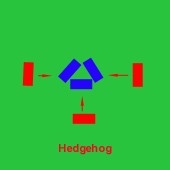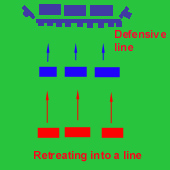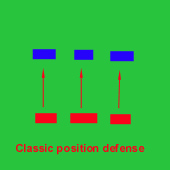|
|
|||||||
|
|
|||||||
|
|
||||||||||
move you troops to the enemy base, but you will decide that your first priority here is to defend your base. One should always weigh all factors before going into an offense, and certainly, one of the factors is the defense. In all campaigns there is the distinction between direct goals and indirect goals. Napoleon set out to conquer Russia, but to do this he wanted to take Moscow. Ludendorff with his Sturm-Tactics in 1918 wanted to take the enemy by surprise, for which he need to concentrate and train troops but he needed a defense strong enough to take all onslaughts in the mean time. Of Montgomery it is said that all his offense successes were preceded by a defensive victory. In this, battle can be compared to chess: are your troops covered, will they hold out. The advantages of bunkers over fields in infantry attacks becomes very |
 |
clear indeed. The defense of his troops is one of the first considerations of a commander: even though in TF we know the respawning principle, it takes time to load up and get respawned players back in position. If a commander attacks and takes an area that is indefensible he/she will have gained nothing in the end. He/she will only have gained an opportunity for the enemy to take out his troops. |
|||
One of the principles of defense is to never ever divide your troops too much. Allthough in the First World War a single wll-armed unit could hold up an army, in TF2-reality a single squad against three enemy squads is bloody murder. Defending is not a dirty word. An often heard complaint in TF/TFC is that there is nobody on defense, in TF2 a commander could and should prevent this from |
happening. A commander must always take into account that he/she at least wants to make it as difficult as possible for the enemy to get to the rear. This in effect could sometimes mean a retreat is called for. However, always remember one thing: a strategic retreat differs completely from an all-out retreat. Too often you will find teamleaders calling out to defend the base from an ongoing attack, and suddenly all offensive actions are broken off, and people stream back to the base, giving the enemy the chance to pursue them, and kill them. |
||||
 |
||||
A retreat that is called for based on circumstance rather then overwhelming defeat is an orderly one. A commander will give all squads their new positions, and they will, orderly, move there. Most importantly, they will then hold the position. As an example you might want to consider the following strategy: Your squads are under heavy attack, losses are frequent and many. A commander might now decide to send the respawners, not up to the frontline, but a second line behind the front. This could be asily done by telling the squads: �if you are fragged, squad 1 troops go to position A, squad 2 goes to position B, etc..�. This line is then used by the respawned troops to orderly set up a defense, so that the frontline may fall back. Once the seond line is ready, meaning your troops are in position (snipers, machine gunners), the front troops are told to retreat, and take up new positions. The enemy will of course advance: a few mines will usually give you some delays. More importantly, the troops retreating will now find their comrades covering their rear. An advancing enemy will find itself under fire from a new defensive line. Usually this can work pretty confusing for an enemy. Especially when this enemy is already wounded, and thinned out: it will find a defensive line consisting of fresh troops, packed with ammo. Anyway, to continue, please use the buttons on the left to navigate. |
